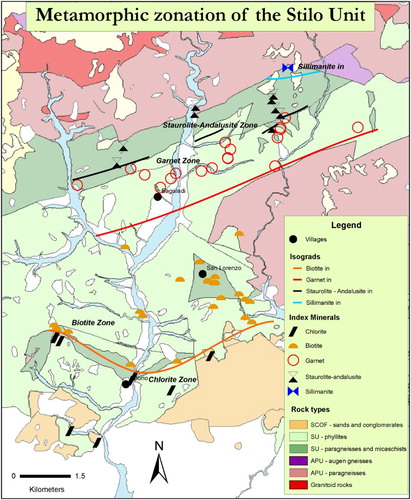Abstract
The structural-geological field survey (1:10,000 scale) of the south-western portions of the Aspromonte Massif (southern Calabria, Italy) clearly reveal a nappe-pile stack made of three main tectono-metamorphic units piled-up by means of tectonic contacts with associated cataclastic or mylonitic rocks developed at various crustal depth. These three units are from top to bottom: the Stilo Unit, the Aspromonte-Peloritani Unit (APU) and the Madonna di Polsi Unit. As part of an ongoing project, we have constructed a structural and metamorphic GIS database based on 285 sampling stations, which allows for metamorphic and structural maps to be obtained in the form of the metamorphic zoning of the SU.. This unit, made up of low greenschist- to low amphibolite-facies Palaeozoic metamorphic rocks, lies through a brittle tectonic contact over the APU, which is made up of amphibolite-facies metamorphic rocks intruded by late Hercynian peraluminous both locally overprinted by Alpine type metamorphism. The petrographic-derived metamorphic zonation chart here presented has been created after the detailed petrographic analysis of about 80 thin sections and the recognition of mineral assemblages of a thermal metamorphic aureole (biotite, muscovite and andalusite blastesis) produced by Late Hercynian magmatic bodies intruded into metapelites (Punta d'Atò granitoids, outcropping in the northern part of the mapped area).
1. Introduction
The study area is located in southern Calabria (Italy) where piled up crystalline basement tectonic slices form the Aspromonte Massif edifice. This massif constitutes, together with the southward Peloritani Mountains (CitationCella et al., 2004; CitationCirrincione, Fazio, Ortolano, Pezzino, & Punturo, 2012) and northerward massifs of Sila and Serre (CitationSchenk, 1990; CitationCaggianelli, Del Moro, Di Battista, Prosser, & Rottura, 2003; CitationCirrincione, Fazio et al., 2012), the Calabria-Peloritani Orogen (CPO. The CPO is a segment of the Alpine chain located in the central Mediterranean area (). For a more detailed geological setting of CPO and the Aspromonte Massif area () please refer to the abundant existing geological literature (e.g. CitationAtzori, Ghisetti, Pezzino, & Vezzani, 1983; CitationBonardi, Messina, Perrone, Russo, & Zuppetta, 1984; CitationGraessner & Schenk, 1999; CitationHeymes et al., 2010) as well as to a recent published research guide (CitationCirrincione et al., 2013 and reference therein).
Figure 1. Geological map of the Calabria-Peloritani Orogen (CPO) in southern Italy (after CitationAngì et al., 2010).
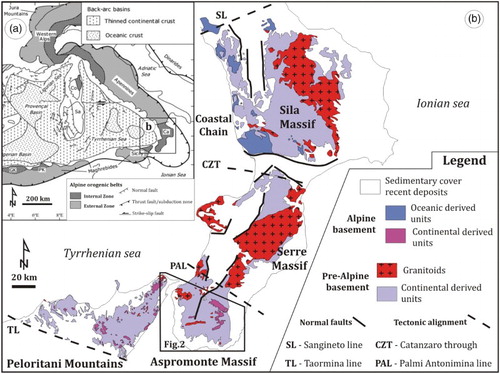
The Aspromonte framework is composed by three main tectono-metamorphic units (–) outlined in the attached map, which are from top to bottom: the Stilo Unit (SU), the Aspromonte-Peloritani Unit (APU) and the Madonna di Polsi Unit (MPU). The SU is made up of Hercynian low-greenschist to amphibolite facies metapelites. The geometrically intermediate APU is composed by Hercynian amphibolite-facies metamorphic rocks, intruded by late – Hercynian granitoid bodies, re-equilibrated during the Alpine orogenesis. The lowermost tectonic slice (MPU) is represented by greenschist-facies metapelites characterized by exclusive Alpine metamorphism. In the Aspromonte Massif region the MPU includes metapelites (essentially garnet-micaschists and phyllites) surfacing into three main tectonic windows named ‘Polsi’, ‘Samo-Africo’, and ‘Cardeto’ (visible in the northern sector of the geological map), from the most important localities occurring nearby. A sedimentary clastic succession from lower Miocene to Pleistocene in age, the Stilo-Capo d'Orlando Formation (SCOF), covers with angular unconformity, the different metamorphic units, sealing at times the contacts. In the studied area the SCOF outcrops only in the southeastern corner of the map showing sometimes, when occurring with its conglomeratic facies, typical erosional shapes forming domes and pinnacles.
Figure 2. Geological sketch map of the Aspromonte Massif. In the lower inset a simplified tectonic scheme illustrating the geometrical relationships between the main crystalline nappes is shown (after CitationCirrincione et al., 2013).
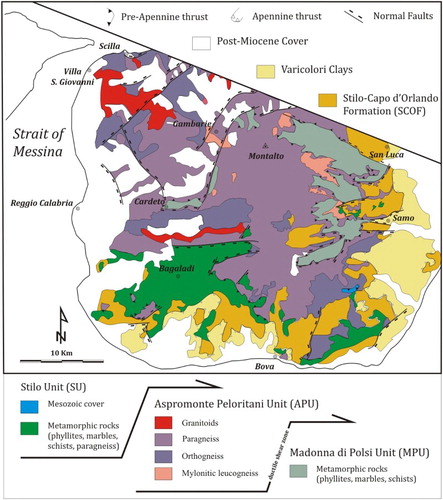
Figure 3. Schematic column of the crystalline nappes constituting the framework of the Aspromonte Massif (not to scale).
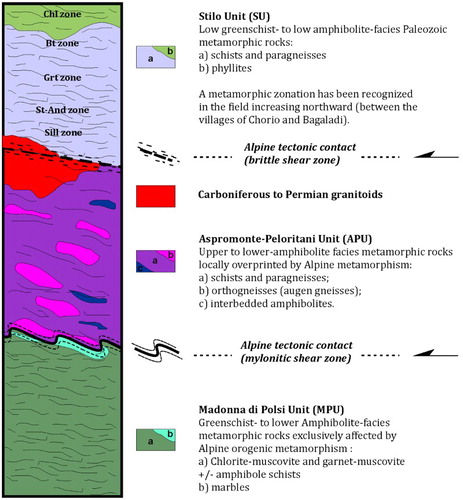
1.1. Map overview
The enclosed Main Map (1:16,000 scale) represents an area of about 140 km2 extended within the administrative territory of the Reggio Calabria town, between the villages of Cardeto to the north and Chorio to the south. The Ionian coastline rests a few kilometers southward, whereas the highest peak of the Aspromonte Massif, Mt. Montalto (1995 m.a.s.l.), is sited about 20 kilometers northeastward.
The physiography of the studied area, with altitudes ranging from ca. 150 to 1450 meters a.s.l., is quite assorted because it varies from flattened surfaces to very steep slopes. The flat morphological elements are represented by alluvial plains next to the riverbeds of so-called ‘fiumare’, the typical streams of the Calabria region, as well as by marine terraces (Holocene to Plio-Plesitocene sands) outcropping above 900 m.a.s.l. (named ‘piani alti’, i.e. high planes), testifying a strong recent uplift of the southern Calabria region by means of horst and graben systems. These regional structures developed during last extensional tectonics phases are NE-SW normal faults accommodated by a NW-SE transtensional fault system (CitationGhisetti and Vezzani, 1981; CitationTortorici, 1982; CitationTripodi, Muto, & Critelli, 2013). The second homogeneous geomorphologic element, characterized by very steep slopes, consists of various peaks essentially made by medium-high-grade crystalline rock (indeed the name ‘Aspromonte’ is a composite word which means sharp crest) resembling the classical landform aspect of alpine regions. The highest peak on the map, Mount Cendri (1446 meters a.s.l.), is located in the northern sector. The main rivers traversing the map are: the Fiumara Amendolea delimiting the eastern border of the chart, the Fiumara Melito in the central part between the villages of Bagaladi and San Lorenzo, and the Fiumara S. Agata in the northern sector. Minor rivers are: Condofuri, Tuccio, Paludi, Pietre Bianche, and Reggio.
2. Methods
The main aim of this structural-geological survey was to delineate the tectono-metamorphic history of crystalline units composing the Aspromonte pile-nappes edifice by means of classical structural geology techniques based on the recognition of structural features in the field such as foliations, lineations, fold axes, faults, cleavages supported by petrographic investigation to establish cross cutting relationships between metamorphic assemblages and observed structures related to deformational episodes. The correct interpretation of microstructural fabrics and their timing relations with respect to deformation allowed us to reconstruct different tectono-thermal evolution for each unit and to discriminate between them. Moreover for the Stilo Unit (SU) a detailed map of metamorphic zonation from chlorite zone to staurolite-andalusite zone (with or without sillimanite) towards north has been constructed thanks to the petrographic observations made on hundreds of thin sections and to recognized mineral assemblages.
3. Tectono-metamorphic units (metamorphic episodes and deformational phases)
In order to distinguish between very similar rocks pertinent to different tectono-metamorphic units (e.g. APU and SU micaschists) a detailed petrographic study together with a careful deformational history reconstruction were made (). This multidisciplinary approach makes possible the appropriate rock-unit correlations to be restored. In the next paragraphs a brief description of the essential features characterizing the three tectono-metamorphic units, starting from the northern part of the map where the lowermost unit outcrops, will be made.
Figure 4. Synoptic table showing relationships between deformational phases (Dn) and metamorphic episodes (Mn) recognized into the three tectono metamorphic units (modified, after CitationPezzino et al., 2008). The light gray filled areas indicate deformational episodes and crystallization events developed during Hercynian time. Note about the subscript/superscript notation: subscripts are composed by a number followed by a letter, the number stays for a specific deformational phases (from 1 to 5) and the letter for Hercynian (H) or Alpine (A) age. The superscripts identify the various tectono-metamorphic units: SU (Stilo Unit), APU (Aspromonte Peloritani Unit), and MPU (Madonna di Polsi Unit). Legend: S = schistosity or foliation; L = stretching lineation; B = fold axis.
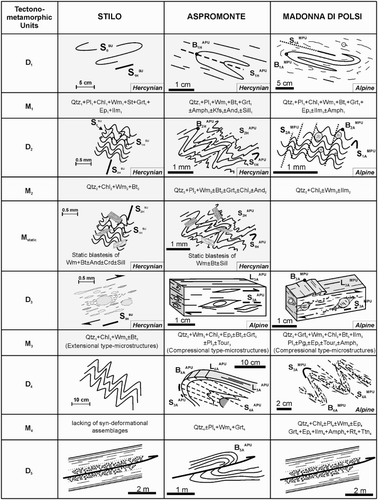
3.1. Madonna di Polsi Unit (MPU)
The lower-greenschist to lower-amphibolite facies metapelitic metapsammitic sequences of MPU (CitationPezzino et al., 1990; Citation2008) is characterized by a polyphase Alpine metamorphism (CitationPezzino et al., 2008; CitationOrtolano, Cirrincione, & Pezzino, 2005; CitationCirrincione et al., 2009; CitationCirrincione, De Vuono et al., 2010; CitationCirrincione, Fazio et al. 2010; CitationFazio, Cirrincione, & Pezzino, 2008; CitationFazio, Cirrincione, & Pezzino 2009; CitationFazio, Punturo, & Cirrincione 2010). It crops out in two tectonic windows exposed near the Cardeto village by the erosive action of two roughly E-W-oriented rivers, the Fiumara S. Agata and Fiumara Reggio.
The tectono-metamorphic evolution of the MPU metapelites (CitationPezzino et al., 1990; CitationOrtolano et al. 2005; CitationCirrincione et al., 2008; CitationFazio et al., 2008; CitationFazio, Punturo, Cirrincione, Ortolano, & Pezzino, 2013) is consistent with the tectonic model hypothesized by CitationPezzino et al. (2008) for the exhumation of HP rocks for the Aspromonte Massif. In particular, two polyphase metamorphic cycles were recognized: (a) the former cycle (M1–2) is related to progressive subsiding of sedimentary successions forming the MPU, which attained relatively HP peak metamorphic conditions (up to 1.35 GPa), consistent with under-plating of thinned continental crust; (b) the later one (M3–4), associated with D3–4 deformation, pervasively overprinting the previous structures, characterized by compressive exhumation along a mylonitic shear zone, is responsible for rapid extrusion along a quasi-adiabatic decompression path. The D3 shearing phase can be considered consistent with an uplifting tectonic channel linked with a high displacement rate (CitationPezzino et al., 2008). This last event evolved to D4 deformation in low-greenschist facies conditions (M4) in a range of T = 350–480°C and P = 0.32–0.62 GPa. The mesoscopic structural features ( and a–b) related to these deformational phases are: a first isoclinal folding, indicated by hinge relics of quartz within phyllite layers, produced an axial plane foliation (S1A). A new surface (S2A) is occasionally developed due to crenulation of S1. The subsequent shear event (D3) produced a pervasive mylonitic foliation S3A (mean 122°/22° in the right-hand-rule notation, RHR), a stretching lineation L3A (mean 225°/20° as dip direction/dip, DD/D), syn-tectonic intrafoliational asymmetrical folds (B3A) evolving to rod structures (mean 135°/8°, DD/D), S-C fabrics and an oblique foliation. A fourth phase caused asymmetrical to isoclinal folding of the S3A mylonitic foliation and also of the tectonic contact between APU and MPU and was followed by a fifth brittle deformational phase (D5) that generated a pervasive fracture cleavage (mean 105°/85°, RHR) and folds evolving into thrust planes.The tectonic contact between APU and MPU is well exposed in the northermost smaller tectonic window (Fiumara Reggio river). It is deeper with respect to the SU-APU thrust, showing a 2 meters thick transitional zone with associated mylonitic rocks of both units isoclinally folded (D4) from centimetric to metric scale (). The mylonitic event (D3 on ; CitationOrtolano et al. 2005, CitationCirrincione et al., 2008; CitationFazio et al., 2008, Citation2013), which thrusted the APU onto the MPU, marks the beginning of the joint structural and metamorphic history of these two units.
Figure 5. (a) Classical appearance of MPU phyllites with crenulated quartz lenses indicating a top-to-the E shear sense suggested by the slight asymmetry of folds; (b) Crenulation cleavage (S2A) developed during D2 deformational phase; (c) augen gneisses of APU (top-to-the NE shear sense); (d) mylonitic shear zone developed within APU augen gneisses (top-to-the NE shear sense).
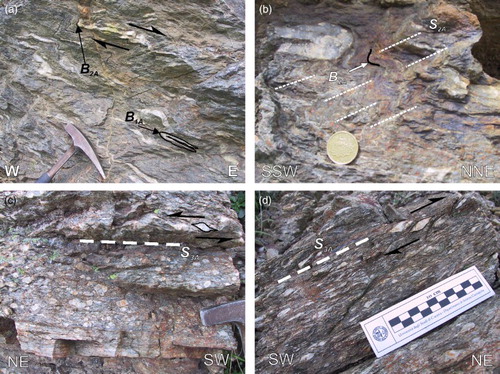
Various metamorphic assemblages related to deformational phases () have been recognized in the MPU metapelites (CitationPezzino et al., 1990, Citation2008): the early recognized metamorphic episode (M1) developed under LT-HP conditions (0.95–1.35 GPa at 400°-600 °C after CitationCirrincione et al., 2008), produced garnet, ilmenite, epidote, chlorite and white mica. Local growth of apatite, plagioclase, biotite and amphibole occur. This assemblage is seldom preserved along the axial planar foliation S1A of isoclinal folds. A weakly developed assemblage composed of white mica, plagioclase, chlorite and ilmenite corresponds to the M2 crystallization episode. These minerals grew along with crenulation cleavage S2A developed syn-tectonically with the second deformational phase D2. The syn-mylonitic metamorphic episode (M3), linked to late Oligocene Alpine deformation is characterized by an assemblage consisting essentially of white mica and biotite laths sub parallel to the S3A foliation, alternating with mm-thick ribbon-like quartz bands, represent the main syn-shear minerals. Other minerals grown during this phase are aragonite, plagioclase (albite to oligoclase), ilmenite, epidote, chlorite, tourmaline, amphibole (essentially tschermakites), and garnet. The assemblage developed coevally with respect to the fourth deformational phase, parallel to the axial surface (S4A) of the asymmetric to isoclinal folds, consists of plagioclase, white mica, chlorite and epidote. The last deformational episode D5 doesn't show any blastesis because it essentially developed in a brittle regime, producing only cataclastic effects superposed on mylonitic rocks (CitationCirrincione et al., 2013).
3.2. Aspromonte-Peloritani Unit (APU)
The most prominent rock types in the APU ((c-d)) are middle crustal biotite paragneisses and augen gneisses with minor amphibolites, mica schists and marbles. Pre-Variscan rocks are long known in southern Calabria, where CitationSchenk and Todt (1989) and CitationSchenk (1990) have reported several zircon U-Pb ages for gneisses from different crustal levels that indicate a late Neoproterozoic (0.6–0.5 Ga) crust-forming event. More recently, CitationMicheletti, Barbey, Fornelli, Piccarreta, and Deloule (2007) have reported latest Precambrian to early Cambrian SIMS zircon ages for the granitic protoliths of augen gneisses bodies of the APU in the Aspromonte Massif, which are the same of those found by CitationWilliams, Fiannacca, Cirrincione, and Pezzino (2012) and CitationFiannacca, Williams, Cirrincione, & Pezzino (2013) for para- and orthogneisses from the Peloritanian counterparts in Sicily.
The earliest metamorphic episodes recognized in the APU metapelites have been ascribed to a polyphase HT-LP retrograde Hercynian evolution. The main deformational phases are represented by an isoclinal folding (D1) evolving to a retrograde crenulation phase (D2) (CitationPezzino et al., 1990; CitationOrtolano et al., 2005). A subsequent shear phase (D3), linked to the exhumation of the basement rocks, is responsible for the emplacement of the APU above the MPU (CitationPezzino et al., 1990, Citation2008). From that deformational episode APU will share with MPU the same tectonic history outlined above (D4–5). APU is overprinted by Alpine metamorphism which developed at about 28 Ma (CitationBonardi et al., 2008; CitationHeymes et al., 2010). P–T estimates for the Hercynian tectono-metamorphic evolution of the rocks of APU range between 650 and 675°C at 0.4–0.5 GPa (CitationOrtolano et al., 2005, Cirrincione et al., 2008). A final widespread episode of hydration under decreasing temperatures (480°C) was probably caused by the massive emplacement of metaluminous to strongly peraluminous late-Hercynian granitoids at about 300 Ma (CitationRottura et al., 1990; CitationGraessner, Schenk, Brocker, & Mezger, 2000; CitationFiannacca, Brotzu, Cirrincione, Mazzoleni, & Pezzino, 2005; CitationFiannacca, Williams, Cirrincione, & Pezzino, 2008). U–Pb monazite ages (CitationGraessner et al., 2000) for amphibolite facies paragneisses indicated a metamorphic peak at 295 to 293 ± 4 Ma (with P–T conditions of 620°C at ca. 0.25 GPa for the base of the upper crust). Despite the absence of detailed geochronological constraints, clockwise P–T–(t) paths inferred for the medium-to high-grade rocks of APU have been considered to be consistent with processes of crustal thickening during early- and middle-Hercynian collisional stages, followed by crustal thinning, granitoid intrusion and unroofing during late- Hercynian extensional stages (e.g. CitationFesta, Messina, Paglionico, Piccarreta, & Rottura 2004; CitationCaggianelli, Liotta, Prosser, & Ranalli, 2007; CitationAngì et al., 2010; CitationAppel, Cirrincione, Fiannacca, & Pezzino, 2011).
3.3. Plutonic complex of Punta d'Atò
In the central section of the research area granitoid rocks (late Carboniferous plutonic body of Punta d'Atò, ) intruding high-grade rocks of APU, are exposed basically following an E-W alignment. Absolute ages of these intrusions span between 303 and 290 Ma (zircon, monazite and xenotime U–Pb ages and whole-rock and micas Rb–Sr ages; CitationBorsi and Dubois, 1968; CitationBorsi, Merlin, Lorenzoni, Paglionico, & Lorenzoni Zanettin, 1976; CitationSchenk, 1980; CitationDel Moro, Maccarrone, Pardini, & Rottura, 1982; CitationGraessner et al., 2000; CitationFiannacca et al., 2008).
Figure 6. Intrusive contact of Punta d'Atò granitoids within hosting APU metapelites: (a) the core zone with fault rocks of a recent normal fault (northern sector of attached map) plane masking the original intrusive contact between plutonic rocks and hosting metamorphic rocks; (b) normal fault superimposed on the sharp intrusive contact (area near Condofuri); (c) the intrusive contact shown here is better preserved (Mt. Peripoli area).
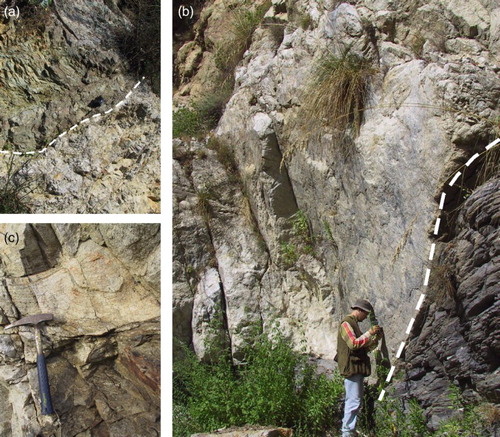
According to CitationGraessner and Schenk (1999) and CitationGraessner et al. (2000) the massive granitoid emplacement in northern and central Calabria (Sila and Serre Massif) which is supposed to be correlated to the smaller intrusive bodies of southern Calabria, like the Punta d'Atò granitoids rocks outcropping in the study area, was responsible for a regional scale late-stage metamorphism. This event occurred under static conditions (Mstatic on ) and resulted in extensive recrystallisation of the mineral assemblages erasing almost all the evidence of previous tectono-metamorphic stages, which are now only rarely preserved (e.g. CitationCaggianelli et al., 2007; CitationAngì et al., 2010; CitationAppel et al., 2011). Often late faults overprint the primary intrusive contacts generating sharper boundaries between plutonic and metamorphic hosting rocks. Nevertheless, sporadically the intrusive primary contact is still preserved into small low-strain domains less affected by latest brittle deformation phases (). A recent petrological and SHRIMP zircon study of the Villa S. Giovanni leucogranodiorites (20 km eastward with respect to the study area) has provided evidence for their derivation from anatexis of a metasedimentary source (CitationFiannacca et al., 2008) and newly acquired zircon data (Fiannacca et al., Citation2012, Citation2013) have showed a strict similarity between the age clusters of the inherited zircon in the leucogranodiorites and those of the detrital zircon in the paragneisses of APU from the Peloritani Mountains (Sicily) suggesting that those paragneisses could be dominant components of the leucogranodiorites magma source.
3.4. Stilo Unit (SU)
The southern sector of the investigated area is essentially made by rocks belonging to the SU (CitationCrisci, Donati, Messina, Russo, & Perrone, 1982; CitationBonardi et al., 1984; CitationFazio, Casini, Cirrincione, Massonne, & Pezzino, 2012) passing from low-grade shales and phyllites to medium- high-grade micaschists ( and ) showing an increasing grade northward, due to regional attitude of foliation, fundamentally verging towards southern quarter (see stereoplots of main foliation in the map inset). Interestingly, for the first time, a narrow shear zone located in the southern flank of Mt. Peripoli characterized by steeply inclined mylonitic foliation ((a)) has been recognized in the micaschists (St-And zone) of SU. Shear planes have been also observed at the same latitude of San Lorenzo and Chorio villages within grey-reddish colored albitic paragneisses ((c-d)). Absolute ages of minerals constituting the synkinematic assemblage are lacking but in our opinion the shear zone should be active during the Hercynian Orogeny because Alpine overprints, like HP assemblages diffusively occurring in the Montalto shearzone (e.g. high phengitic white mica or paragonite, ) are lacking. Moreover the microstructures found in SU rocks (e.g. boudinaged fragmented feldspars) reveal a fabric correlated to an extensional deformation rather than a compressional one, which on the contrary has been extensively developed in the Montalto shear zone. The extensional shear zone recognized in the SU can be tentatively correlated to the late-Hercynian extensional phase (extensively recognized also in the APU) linked to a crustal thinning which has favored the emplacement of granite bodies in the whole region of the Calabrian-Peloritani Orogen.
Figure 7. (a) SU micaschists affected by a shear zone characterized by subvertical mylonitic foliation near Mt. Peripoli (central sector of the geological map); (b) classical appearance of SU phyllites near Bagaladi village; (c-d) phyllonites near San Lorenzo village with quartz lenses showing asymmetrical folds (top to the left sense of shear).
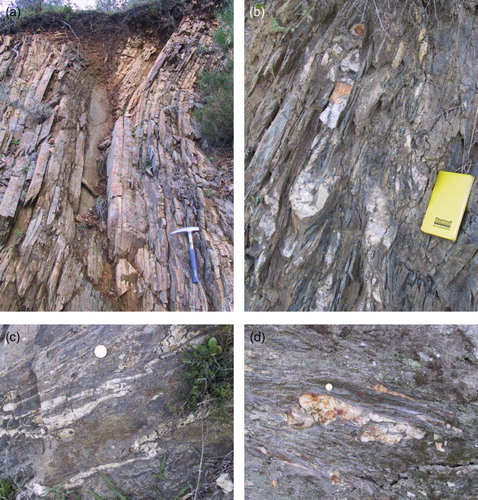
Figure 8. Deformational phases recognized for SU metapelites both at mesoscale (a,c) and microscale (b, d): (a) isoclinal fold of a quartz lens within phyllites near Bagaladi village; (b) thin section showing relationships between S0H and S1H foliations; (c) S2H crenulation cleavage visible into a micaschist of SU (biotite metamorphic zone); (d) thin section of a biotite-chlorite schist showing axial planes of microfolds forming a clear new foliation (S2H); (e) Shear deformational phase recognized in fine grained albite-paragneisses of SU highlighted by rounded feldspar clast with asymmetrical strain shadows where muscovite grows; (f) strain shadows of feldspar indicating a top-to-the west sense of shear (sample collected near San Lorenzo village, southern sector of study area).
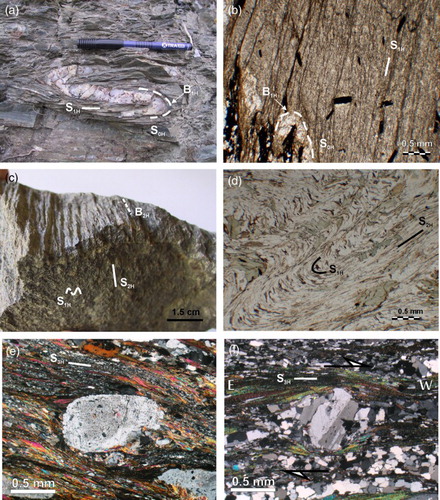
The very similar metamorphic grade and assemblages of rocks near the thrust plane which separates SU from APU, makes difficult during the field-survey the discrimination between high-grade metapelitic rocks of the APU and St-And-Grt schists of the deepest levels of the SU (i.e. in northern sited outcrops, according to CitationHeymes et al., 2008 and references therein). The same problem has not been encountered with other types of rocks, like ortho- and augen-gneisses of APU, easily identifiable in the field or when grey-colored low-grade phyllites of SU tectonically overlay high-grade rocks of APU (i.e. clear thrust plane near Condofuri village, ). Despite the similarity between paragneisses belonging to APU and SU some differences occur: 1) APU paragneisses are characterized by migmatitic fabric with centimeter thick leucosomatic levels alternating to pelitic ones, which are never observed in the SU rocks; 2) their high-grade metamorphic assemblages (Sill + St + And + Grt + Crd) only apparently are similar because for example staurolite, sporadic in APU rocks is limited to very scanty sporadic grains whereas it is a fundamental constituent of SU paragneisses forming porphyroblasts as well as andalusite and garnet.
Figure 9. Panoramic view of the tectonic contact between APU and SU metamorphic rocks. Photo taken by the Amendolea Castle (Fiumara Amendolea, south-eastern sector of study area). The Stilo Capo D'Orlando Formation (SCOF, conglomerate facies) discordantly drapes the SU metapelites forming isolated caps.

The deformational phases recognized in the SU ( and ) can be summarized as follows: (D1) isoclinal folding (B1H axis) of a previous surface, involving the formation of a new axial plane foliation (S1H); (D2H) the crenulation of S1H, which creates a new crenulation cleavage foliation (S2H) with an associated microfolds hinge lineation (B2H); field investigation and preliminary microstructural observations suggest the occurrence of a locally developed shearing deformational phase (D3H) leading to the formation of mylonitic rocks, with development of a new mylonitic foliation (S3H). Nevertheless these evidences should be further constrained and will be studied in the future because structures related to this event are not easily recognizable into true metapelites (i.e. phyllonites), but they appear more evident in the interbedded fine grained albite-paragneisses and quartz-rich phyllites ((f)); (D4) a late folding episode producing chevron geometry type folds (without associated blastesis) from meter to decameter wavelength scale, evolving into the last deformational phase (D5) developed at upper crustal levels responsible for the over thrusting of the entire SU above APU.
4. Conclusions
This geological-structural survey confirmed the overall stacking of three crystalline nappes composing the framework of the Aspromonte Massif edifice. Collection of numerous samples from different tectono-metamorphic units following specific transects orthogonally oriented with respect regional attitude foliation and the preparation of several thin sections allowed a realistic metamorphic assemblages distribution especially for the SU to be drawn. The information stored into the geo-referenced GIS database allowed us to construct a metamorphic zonation map of the whole unit from chlorite zone to the sillimanite zone (). Moreover, narrow shear zones have been reported for the first time in this area, to our knowledge, within the SU, which need to be further investigated in order to clarify their tectonic significance (kinematism, PT conditions) within the tectono-metamorphic evolution of this unit.
Software
The software used during the production of the map were ArcGis ® (desktop version) together with Arcpad ® by ESRI for mobile devices used outdoor, whereas OziExplorer ® was adopted for making coordinate conversions and for superimposing a kilometric grid reticulate on the topographic base map (1:10,000 scale by the Istituto Geografico Militare, IGM), which was useful in the initial phase of the geological survey for planning itineraries and possible sampling traverses.
TJOM_962634_supplemental_material.zip.pdf
Download PDF (253.8 KB)TJOM_962634_supplemental_material.zip__2_.pdf
Download PDF (62.1 MB)Acknowledgements
We appreciated the help and hospitality of all Calabrian inhabitants which we met in the field during our stay. We are also grateful to the whole staff of the Aspromonte National Park, especially the park rangers for their useful suggestions regarding the walking routes we traversed during our fieldwork. We are extremely grateful to Juan Gómez Barreiro and Salvatore Critelli whose constructive and careful review has improved the early version of the manuscript. The final version of the map has benefited by the useful suggestions of Chandra Jayasuriya.
References
- Angì, G., Cirrincione, R., Fazio, E., Fiannacca, P., Ortolano, G., & Pezzino, A. (2010). Metamorphic evolution of preserved Hercynian crustal section in the Serre Massif (Calabria–Peloritani Orogen, southern Italy). Lithos, 115(1–4), 237–262. doi: 10.1016/j.lithos.2009.12.008
- Appel, P., Cirrincione, R., Fiannacca, P., & Pezzino, A. (2011). Age constraints on Late Paleozoic evolution of continental crust from electron microprobe dating of monazite in the Peloritani Mountains (southern Italy): Another example of resetting of monazite ages in high-grade rocks. International Journal of Earth Sciences, 100, 107–123. doi: 10.1007/s00531-010-0511-8
- Atzori, P., Ghisetti, F., Pezzino, A., & Vezzani, L. (1983). Carta geologica del bordo occidentale dell'Aspromonte. S.EL.CA., Firenze, Scale 1: 50,000.
- Bonardi, G., Compagnoni, R., Del Moro, A., Macaione, E., Messina, A., & Perrone, V. (2008). Rb–Sr age constraints on the Alpine metamorphic overprint in the Aspromonte Nappe (Calabria–Peloritani Composite Terrane, southern Italy). Boll. Soc. Geol. It., 127, 173–190.
- Bonardi, G., Messina, A., Perrone, V., Russo, S., & Zuppetta, A. (1984). L'unita di Stilo nel settore meridionale dell'Arco Calabro-Peloritano. Boll. Soc. Geol. It., 103, 279–309.
- Borsi, S., & Dubois, R. (1968). Donnees geochronologiques sur l'histoire hercynienne et alpine de la Calabre centrale. Cr Acad. Sci. Paris, 266, 72–75.
- Borsi, S., Merlin, H. O., Lorenzoni, S., Paglionico, A., & Lorenzoni Zanettin, E. (1976). Stilo Unit and “Dioritic-Kinzingitic” Unit in Le.
- Caggianelli, A., Del Moro, A., Di Battista, P., Prosser, G., & Rottura, A. (2003). Leucogranite genesis connected with low-pressure high-temperature metamorphism in the Sila basement (Calabria, Italy). Schweiz. Mineral. Petrogr. Mitt., 83, 301–316.
- Caggianelli, A., Liotta, D., Prosser, G., & Ranalli, G. (2007). Pressure–temperature evolution of the late Hercynian Calabria continental crust: Compatibility with post-collisional extensional tectonics. Terra Nova, 19, 502–514. doi: 10.1111/j.1365-3121.2007.00777.x
- Cella, F., Cirrincione, R., Critelli, S., Mazzoleni, P., Pezzino, A., Punturo, R., Fedi, M., & Rapolla, A. (2004). Gravity modeling in fold-thrust belts: An example from the Peloritani Mountains, Southern Italy. International Geology Review, 46, 1042–1050. doi: 10.2747/0020-6814.46.11.1042
- Cirrincione, R., De Vuono, E., Fazio, E., Fiannacca, P., Ortolano, G., Pezzino, A., & Punturo, R. (2010). The composite framework of the southern sector of the Calabria Peloritani Orogen. Rendiconti Online Società Geologica Italiana, 11, 93–94.
- Cirrincione, R., Fazio, E., Fiannacca, P., Ortolano, G., Pezzino, A., & Punturo, R. (2012). Quartz annealing microstructures in sheared rocks from the Serre Massif (Calabria, Italy). Rendiconti Online Societa Geologica Italiana, 21, 126–128.
- Cirrincione, R., Fazio, E., Fiannacca, P., Ortolano, G., Pezzino, A., Punturo, R., Romano, V., & Sacco, V. (2013). The Alpine evolution of the Aspromonte Massif: Constraints for geodynamic reconstruction of the Calabria-Peloritani Orogen. Geological Field Trips, 5, 1–73.
- Cirrincione, R., Fazio, E., Fiannacca, P., Ortolano, G., & Punturo, R. (2009). Microstructural Investigation of Naturally Deformed Leucogneiss from an Alpine Shear Zone (Southern Calabria – Italy). Pure And Applied Geophysics, 166, 995–1010. doi: 10.1007/s00024-009-0483-4
- Cirrincione, R., Fazio, E., Heilbronner, R., Kern, H., Mengel, K., Ortolano, G., Pezzino, A., & Punturo, R. (2010). Microstructure and elastic anisotropy of naturally deformed leucogneiss from a shear zone in Montalto (southern Calabria, Italy). Geological Society Of London, Sp. Publ., 332, 49–68. doi: 10.1144/SP332.4
- Cirrincione, R., Fazio, E., Ortolano, G., Pezzino, A., & Punturo, R. (2012). Fault-related rocks: Deciphering the structural–metamorphic evolution of an accretionary wedge in a collisional belt, NE Sicily. International Geology Review, 54, 940–956. doi: 10.1080/00206814.2011.623022
- Cirrincione, R., Ortolano, G., Pezzino, A., & Punturo, R. (2008). Poly-orogenic multi-stage metamorphic evolution inferred via P–T pseudosections: An example from Aspromonte Massif basement rocks (Southern Calabria, Italy). Lithos, 103, 466–502.
- Crisci, G. M., Donati, G., Messina, A., Russo, S., & Perrone, V. (1982). L'Unità superiore dell'Aspromonte. Studio geologico e petrografico. Rend. S.I.M.P., 38, 989–1014.
- Del Moro, A., Maccarrone, E., Pardini, G., & Rottura, A. (1982). Studio radiometrico Rb/Sr di granitoidi peraluminosi dell'Arco Calabro Peloritano. Rend. Soc. Ital. Mineral. Petrol., 38, 1015–1026.
- Fazio, E., Casini, L., Cirrincione, R., Massonne, H.-J., & Pezzino, A. (2012). P-T estimates for the metamorphic rocks of the Stilo Unit (Aspromonte Massif, Calabria) and correlations with analogue Sardinian Variscan crystalline complexes. Special meeting of French and Italian Geological Societies “Variscan 2012”, May-22–23 Sassari, Italy. Geologie de la France, 1, 111–113.
- Fazio, E., Cirrincione, R., & Pezzino, A. (2008). Estimating P-T conditions of Alpine-type metamorphism using multistage garnet in the tectonic windows of the Cardeto area (southern Aspromonte Massif, Calabria). Mineralogy and Petrology, 93, 111–142. doi: 10.1007/s00710-007-0216-2
- Fazio, E., Cirrincione, R., & Pezzino, A. (2009). Garnet crystal growth in sheared metapelites (southern Calabria – Italy): Relationships between isolated porphyroblasts and coalescing euhedral crystals. Periodico di Mineralogia, 78, 3–18.
- Fazio, E., Punturo, R., & Cirrincione, R. (2010). Quartz c-axis texture mapping of mylonitic metapelite with rods structures (Calabria, southern Italy): Clues for hidden shear flow direction. Journal of the Geological Society of India, 75, 171–182. doi: 10.1007/s12594-010-0006-z
- Fazio, E., Punturo, R., Cirrincione, R., Ortolano, G., & Pezzino, A. (2013). Quantitative microstructures of polycrystalline quartz aggregates in a mylonite: Implication for strain-rate evaluation. Rendiconti Online Societa Geologica Italiana, 29, 47–50.
- Festa, V., Messina, A., Paglionico, A., Piccarreta, G., & Rottura, A. (2004). Pre-Triassic history recorded in the Calabria–Peloritani segment of the Alpine chain, southern Italy. An overview. Periodico Mineralogia, 73, 57–71.
- Fiannacca, P., Brotzu, P., Cirrincione, R., Mazzoleni, P., & Pezzino, A. (2005). Alkali metasomatism as a process for trondhjemite genesis: Evidence from Aspromonte Unit, north-eastern Peloritani, Sicily. Mineralogy and Petrology, 84, 19–45. doi: 10.1007/s00710-005-0073-9
- Fiannacca, P., Williams, I. S., Cirrincione, R., & Pezzino, A. (2008). Crustal contributions to late Hercynian peraluminous magmatism in the Southern Calabria-Peloritani Orogen, Southern Italy: Petrogenetic inferences and the Gondwana connection. Journal of Petrology, 49, 1497–1514. doi: 10.1093/petrology/egn035
- Fiannacca, P., Williams, I. S., Cirrincione, R., & Pezzino, A. (2012). Late Cadomian and late Variscan granitoid magmatism in the southern Calabria-Peloritani Orogen (southern Italy). Rend. Online Soc. Geol. It., 21, 131–132.
- Fiannacca, P., Williams, I. S., Cirrincione, R., & Pezzino, A. (2013). The augen gneisses of the Peloritani Mountains (NE Sicily): Granitoid magma production during rapid evolution of the northern Gondwana margin at the end of the Precambrian. Gondwana Research, 23, 782–796. doi: 10.1016/j.gr.2012.05.019
- Ghisetti, F., & Vezzani, L. (1981). Contribution of structural analysis to understanding the geodynamic evolution of the Calabrian Arc (Southern Italy). J. Struct. Geol., 3, 371–381. doi: 10.1016/0191-8141(81)90037-7
- Graessner, T., & Schenk, V. (1999). Low-pressure metamorphism of Palaeozoic pelites in the Aspromonte, southern Calabria: Constraints for the thermal evolution in the Calabrian crustal cross-section during the Hercynian orogeny. Journal of Metamorphic Geology, 17, 157–172. doi: 10.1046/j.1525-1314.1999.00188.x
- Graessner, T., Schenk, V., Brocker, M., & Mezger, K. (2000). Geochronological constraints on timing of granitoid magmatism, metamorphism and post-metamorphic cooling in the Hercynian crustal cross-section of Calabria. J. Metam. Geol., 18, 409–421. doi: 10.1046/j.1525-1314.2000.00267.x
- Heymes, T., Bouillin, J.-P. , Pêcher, A., Monié, P., & Compagnoni, R. (2008). Middle Oligocene extension in the Mediterranean Calabro-Peloritan belt (southern Italy): Insights from the Aspromonte nappes pile. Tectonics, 27, TC2006.
- Heymes, T., Monie, P., Arnaud, N., Pecher, A., Bouillin, J. P., & Compagnoni, R. (2010). Alpine tectonics in the Calabrian–Peloritan belt (southern Italy): New 40Ar/39Ar data in the Aspromonte Massif area. Lithos, 114, 451–472. doi: 10.1016/j.lithos.2009.10.011
- Micheletti, F., Barbey, P., Fornelli, A., Piccarreta, G., & Deloule, E. (2007). Latest Precambrian to Early Cambrian U–Pb zircon ages of augen gneisses from Calabria (Italy), with inference to the Alboran microplate in the evolution of the peri-Gondwana terranes. Inter. Jour. Earth Scien., 96, 843–860. doi: 10.1007/s00531-006-0136-0
- Ortolano, G., Cirrincione, R., & Pezzino, A. (2005). P-T evolution of Alpine metamorphism in the southern Apromonte Massif (Calabria - Italy). Schweizerische Mineralogische und Petrographische Mitteilungen, 85, 31–56.
- Pezzino, A., Angì, G., Cirrincione, R., De Vuono, E., Fazio, E., Fiannacca, P., Lo Giudice, A., Ortolano, G., & Punturo, R. (2008). Alpine Metamorphism in the Aspromonte Massif: Implications for a new framework for the southern sector of the Calabria-Peloritani Orogen, Italy. International Geology Review, 50, 423–441. doi: 10.2747/0020-6814.50.5.423
- Pezzino, A., Pannucci, S., Puglisi, G., Atzori, P., Ioppolo, S., & Lo Giudice, A. (1990). Geometry and metamorphic environment of the contact between the Aspromonte - Peloritani Unit (Upper Unit) and Madonna dei Polsi Unit (Lower Unit) in the central Aspromonte area (Calabria). Boll. Soc. Geol. It., 109, 455–469.
- Rottura, A., Bargossi, G. M., Caironi, V., Del Moro, A., Maccarrone, E., Macera, P., Paglionico, A., Petrini, R., Piccareta, G., & Poli, G. (1990). Petrogenesis of contrasting Hercynian granitoids from the Calabrian Arc, Southern Italy. Lithos, 24, 97–119. doi: 10.1016/0024-4937(90)90019-W
- Schenk, V. (1980). U-Pb and Rb-Sr radiometric dates and their correlation with metamorphic events in the granulitic-facies basement of the Serra, Southern Calabria (Italy). Contributions to Mineralogy and Petrology, 73, 23–38. doi: 10.1007/BF00376258
- Schenk, V. (1990). The exposed crustal cross section of southern Calabria, Italy: Structure and evolution of a segment of Hercynian crust. In M. H. Salisbury and D. M. Fountain (Eds.), Exposed cross sections of the continental crust (pp. 21–42). Dordrecht: Kluwer.
- Schenk, V., & Todt, W. (1989). The age of the Adriatic crust in Calabria (southern Italy): Constraints from U–Pb zircon data. Terra Abstracts, 1, 350. Serre (Calabria, Italy). Geological, petrological, geochronological characters. Boll. Soc. Geol. It., 95, 219–244.
- Tortorici, L. (1982). Lineamenti geologico-strutturali dell'Arco Calabro Peloritano. Rend. Soc. It. Mineral. Petr., 4, 927–940.
- Tripodi, V., Muto, F., & Critelli, S. (2013). Structural style and tectono-stratigraphic evolution of the Neogene-Quaternary Siderno Basin, southern Calabrian Arc, Italy. International Geology Review, 55, 468–481. doi: 10.1080/00206814.2012.723859
- Williams, I. S., Fiannacca, P., Cirrincione, R., & Pezzino, A. (2012). Peri-Gondwanan origin and early geodynamic history of NE Sicily: A zircon tale from the basement of the Peloritani Mountains. Gondwana Research, 22, 855–865. doi: 10.1016/j.gr.2011.12.007

